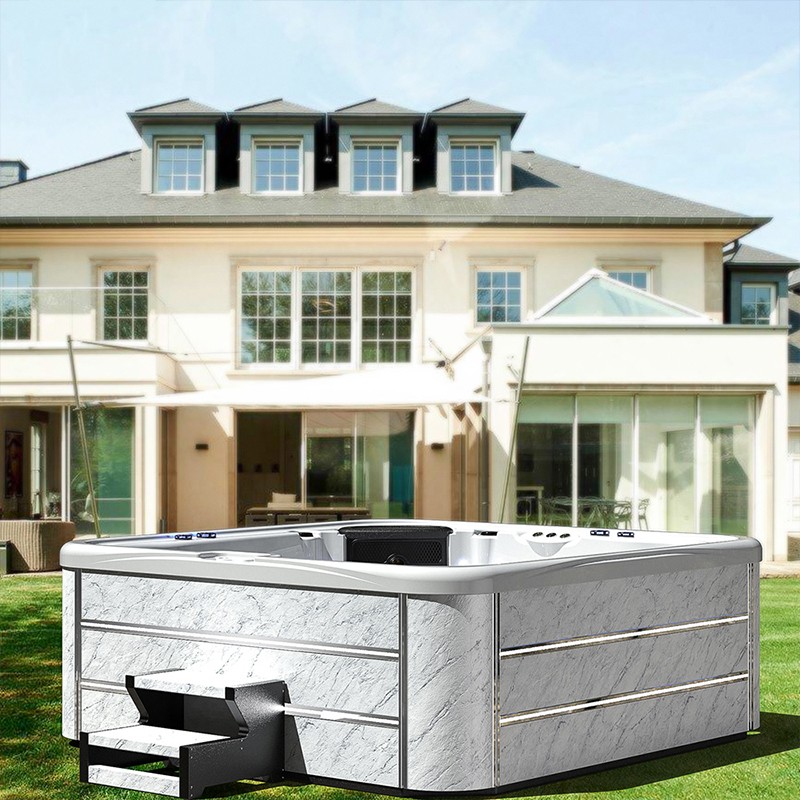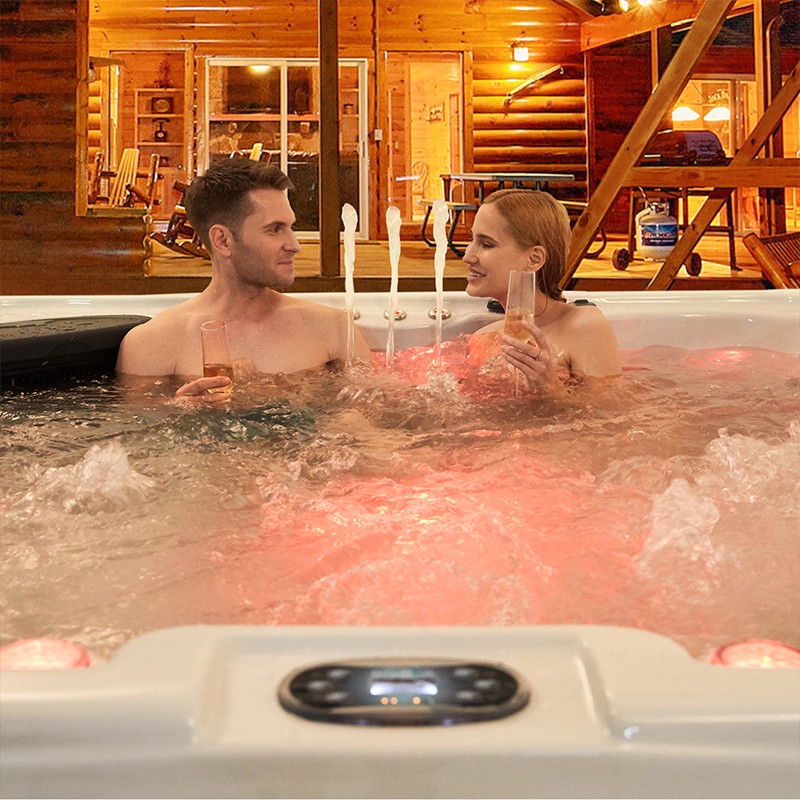
Can I use an outdoor whirlpool hot tub if there is no chlorine in it?
2025-05-08 15:30Outdoor whirlpool hot tubs are widely used in homes as a spa for enjoying relaxation and relieving stress. In these bathtubs, maintaining water quality is crucial to ensuring the user experience, especially the cleanliness and safety of the water. Therefore, the use of chlorine has become an important water treatment method in many outdoor whirlpool hot tubs.
Chlorine is a powerful disinfectant that is often used to disinfect swimming pools, whirlpool hot tubs and other water bodies to prevent the growth of bacteria, algae and other microorganisms. However, if there is no chlorine in the outdoor whirlpool hot tub, can users continue to use the bathtub? This question involves all aspects of water quality control and is directly related to the health and safety of users.
This article will discuss in detail the role of chlorine in outdoor whirlpool hot tubs, the risks that may arise without chlorine, alternative methods, and relevant suggestions on how to properly maintain the water quality of the bathtub.

What is the role of chlorine in outdoor whirlpool hot tubs?
In most outdoor whirlpool hot tubs, chlorine is used as a disinfectant to sterilize, remove pollutants and inhibit the growth of algae. Since the water in the outdoor whirlpool hot tub is exposed to the air and is easily affected by various sources of pollution, chlorine can effectively keep the water clean and prevent the growth of germs. Specifically, the main effects of chlorine in water are as follows:
1. Sterilization
Chlorine can effectively kill bacteria, viruses and other microorganisms in the water. The water in the outdoor whirlpool hot tub is usually affected by the external environment, such as insects, dust, fallen leaves, etc. These pollutants provide soil for bacteria to grow. Chlorine can destroy the cell structure of these microorganisms and make them unable to reproduce, thereby effectively preventing pathogens in the water.
2. Preventing algae growth
Algae grows rapidly in humid environments, especially in warm water bodies. Algae not only affects the beauty of water quality, but also may cause safety hazards such as slips. Chlorine limits the growth of algae by controlling organic matter and other nutrients in the water, thereby keeping the water clear and the outdoor whirlpool hot tub hygienic.
3. Remove organic matter and impurities from water
Chlorine not only kills microorganisms, but also reacts with organic matter in outdoor whirlpool hot tub water to form chlorides, thereby effectively removing impurities from the water. For example, sweat, skin flakes, cosmetic residues, etc. can be decomposed and removed by the action of chlorine to keep the water clean.
4. Maintain water quality balance
Chlorine can also help keep the pH value of outdoor whirlpool hot tub water within a suitable range by reacting with chemicals in the water. The balance of water quality directly affects the comfort and safety of water. Therefore, chlorine is not only a disinfectant, but also an important tool for water quality regulation.

Can I use chlorine if there is no chlorine in the outdoor whirlpool hot tub?
Although we sometimes hope to omit the use of chlorine, especially when avoiding chemical contact, there are some obvious risks in outdoor whirlpool hot tubs without chlorine, mainly reflected in the deterioration of water quality and health risks:
1. Bacteria and virus breeding
Without chlorine or other disinfectants, the number of bacteria and viruses in the water may increase rapidly. The growth of bacteria and viruses not only causes dirty water, but also poses health risks, especially when multiple people share an outdoor whirlpool hot tub, the risk of cross-infection increases significantly. Common waterborne pathogens include E. coli, Salmonella, Mycobacterium flexuosa, etc., which can cause skin infections, respiratory diseases and even gastrointestinal problems.
2. Algae infestation
Algae easily reproduces in water without chlorine. Algae not only affects the appearance of the outdoor whirlpool hot tub, but also makes the surface of the tub slippery, increasing the risk of slipping. In addition, some types of algae, such as blue-green algae, may also contain harmful toxins that threaten the health of users.
3. Unclear water quality
Water without chlorine is prone to turbidity, which not only affects the appearance and user experience of the tub, but may also accelerate the damage of the equipment. Turbid water is usually rich in organic matter, which may accumulate over time to form dirt and adhere to components such as water pumps, pipes, and nozzles, affecting the normal operation of the outdoor whirlpool hot tub.
4. Odor generation
As organic matter and microorganisms accumulate in the water, outdoor whirlpool hot tub water may emit an unpleasant odor. This odor is usually caused by bacteria and corrupt substances in the water. When entering the bathtub, users may smell unpleasant odors such as mold and odor, which affects the user experience.

Alternative methods when there is no chlorine
Although chlorine is the most common water treatment agent, outdoor whirlpool hot tub users can also choose other methods to replace chlorine to disinfect water quality and keep the water clean and hygienic. The following are several common alternative methods:
1. Ozone disinfection
Ozone is a strong oxidant with excellent disinfection ability. Ozone can kill bacteria and viruses in water and decompose organic matter in water. Ozone disinfection systems can generate ozone through a special ozone generator and release it into the water. Compared with chlorine, ozone does not produce harmful byproducts and is therefore more environmentally friendly. Outdoor whirlpool hot tubs disinfected with ozone have fresher water quality and less irritation to the skin and eyes.
2. Ultraviolet disinfection
Ultraviolet (UV) is a colorless and odorless light that can effectively destroy the DNA of bacteria, viruses and algae, thereby achieving the effect of disinfection. UV disinfection equipment is generally installed in the water circulation system of outdoor whirlpool hot tubs. When the water flows through the UV lamp, it will be irradiated and kill microorganisms in the water. The advantage of UV disinfection is that it does not produce chemical residues and does not affect the pH value of water. However, UV disinfection cannot eliminate impurities in water or remove organic matter, so it is usually combined with other water treatment methods.
3. Salt water disinfection system
Salt water system is a disinfection method that uses salt instead of chlorine. This system converts salt into chlorine through an electrolysis process to achieve the purpose of disinfecting water quality. The advantages of salt water system are lower salt concentration and less irritation to the skin during use. At the same time, the chlorine in the salt water system is consumed more slowly and needs to be replenished less frequently. Salt water disinfection system can also effectively prevent the growth of bacteria, viruses and algae, but it still needs regular inspection and maintenance to ensure its disinfection effect.
4. Natural mineral or enzyme products
For users who do not like to use any chemical disinfectants, natural mineral or enzyme products can be selected to help maintain the cleanliness of the water. There are some natural mineral products designed specifically for outdoor whirlpool hot tubs on the market. These products can help break down organic matter in the water and reduce the growth of microorganisms. Enzyme products keep the water clean by breaking down impurities such as grease and dirt in the water. Although this method is more natural and environmentally friendly, it may have limited effectiveness in cases of large-scale pollution or deterioration of water quality.

The importance of properly maintaining the water quality of outdoor whirlpool hot tubs
Whether you choose to use chlorine or other water treatment methods, maintaining good water quality is key to ensuring the normal operation and user experience of outdoor whirlpool hot tubs. Here are some important tips for maintaining water quality:
1. Change the water source regularly
It is recommended to change the water in the whirlpool hot tub every once in a while, especially after a long period of non-use. Regular water changes can effectively remove accumulated organic matter and microorganisms, thereby ensuring the cleanliness of the water.
2. Keep the water pump and filter clean
The water pump and filter are key equipment to ensure the clean water quality of the whirlpool hot tub. Regularly check and clean these equipment, especially the filter, to prevent dirt accumulation from affecting the water quality. The filter element and water pump should be replaced regularly to ensure their normal operation.
3. Check the water quality regularly
Regularly check the pH value, chlorine content, alkalinity and other parameters of the whirlpool hot tub water to ensure the water quality is balanced. Specialized water quality testing tools can be used to test the quality of the water and adjust the water quality in time to ensure that the water is non-toxic, harmless and suitable for use.
Lovia Spa is more than a spa factory—we’re your full-service wellness solution provider. From design to delivery, we offer personalized support, bulk pricing, and global logistics. Our high-performing products are tested and certified for markets across Europe, North America, and beyond. Explore our wholesale deals and purchase directly from China’s leading spa manufacturer.
